Scaling Celeste Mountain II
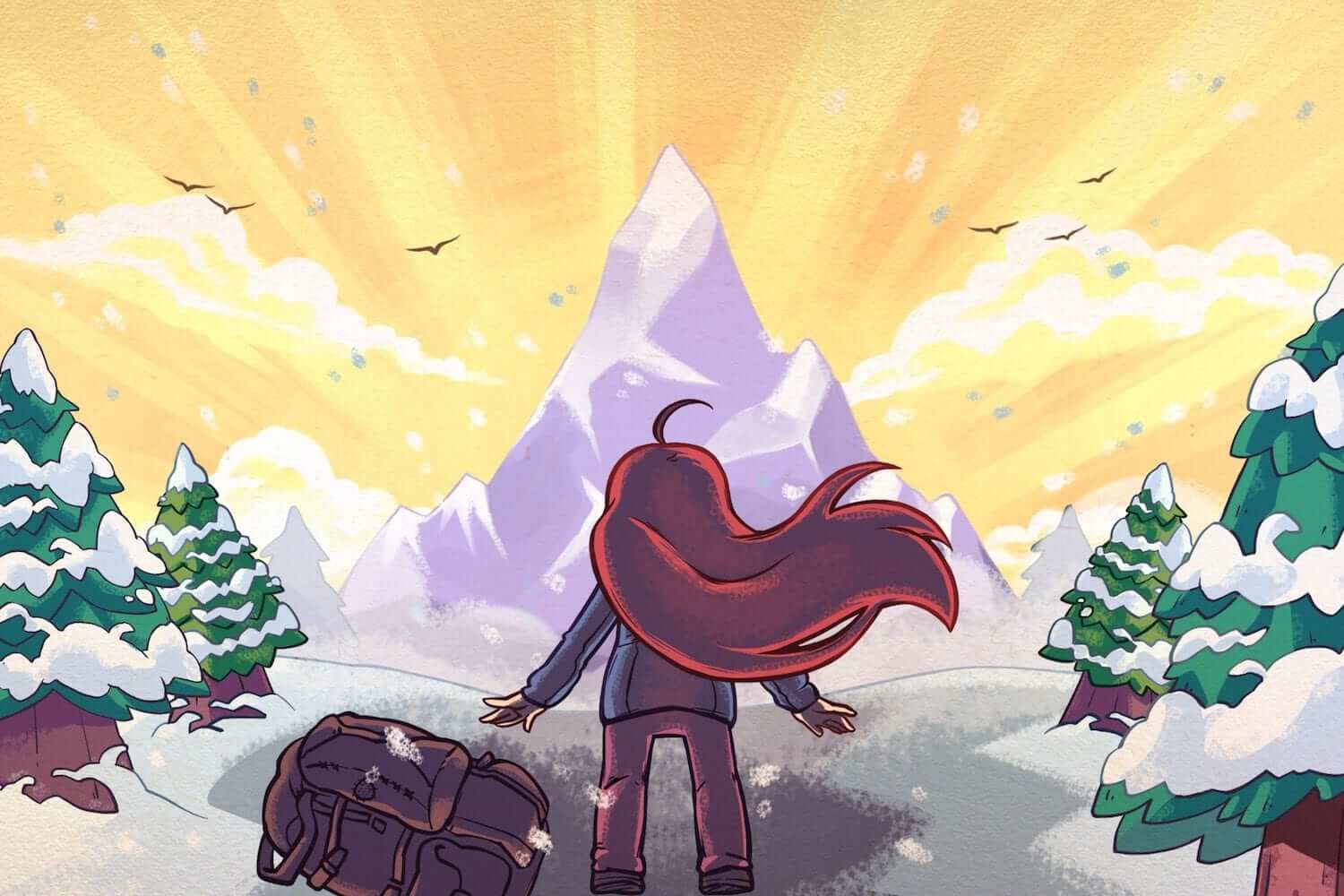
Celeste is one of the most memorable games I’ve played this year. A brilliant masterpiece, it developed in me a profound appreciation of games as a vehicle for creative expression. Read more about my journey in scaling Celeste Mountain in this three-part series.
In the first section, we looked into how Celeste’s storytelling was executed by enabling the player to share with Madeline’s struggles in a plot-focused perspective. In this section, we’ll look into how it was achieved by combining both gameplay and musical elements into the narrative, drawing me closer to Madeline’s journey.
I decided to break this post into a three-part series:
- Part I: Introduction and Storytelling: I’ll introduce Celeste the game, and talk about how its strong narrative has drawn me into completing it.
- Part II: Mechanics is the Message, Story in Sounds (this page): I’ll talk about how Celeste’s precision-platformer mechanics and masterful soundtrack contributed to the storyline and enriched the gameplay and experience even further.
- Part III: Conclusion (August 22): in the final part of this series, I’ll end with a short Conclusion and reflection on Celeste overall, how it changed my perception on video games, and more.
Spoiler Warning!
This review will contain a lot of spoilers in Celeste the game. If you haven’t played the game, try it out first then come back later!
The Mechanics is the message
Earlier, I mentioned that the genius of Celeste’s gameplay is in its ability to help me empathize with Madeline’s struggles as she scales the Mountain—which, as we’ve seen in the first section, was communicated through its story. Here, I’ll discuss how it was achieved through Celeste’s precision-platformer mechanics, particularly, (1) by focusing on player creativity, and (2) its forgiveness & patience.
Before we start, I’d like to talk about how difficult Celeste is! I mean, look at this screen:
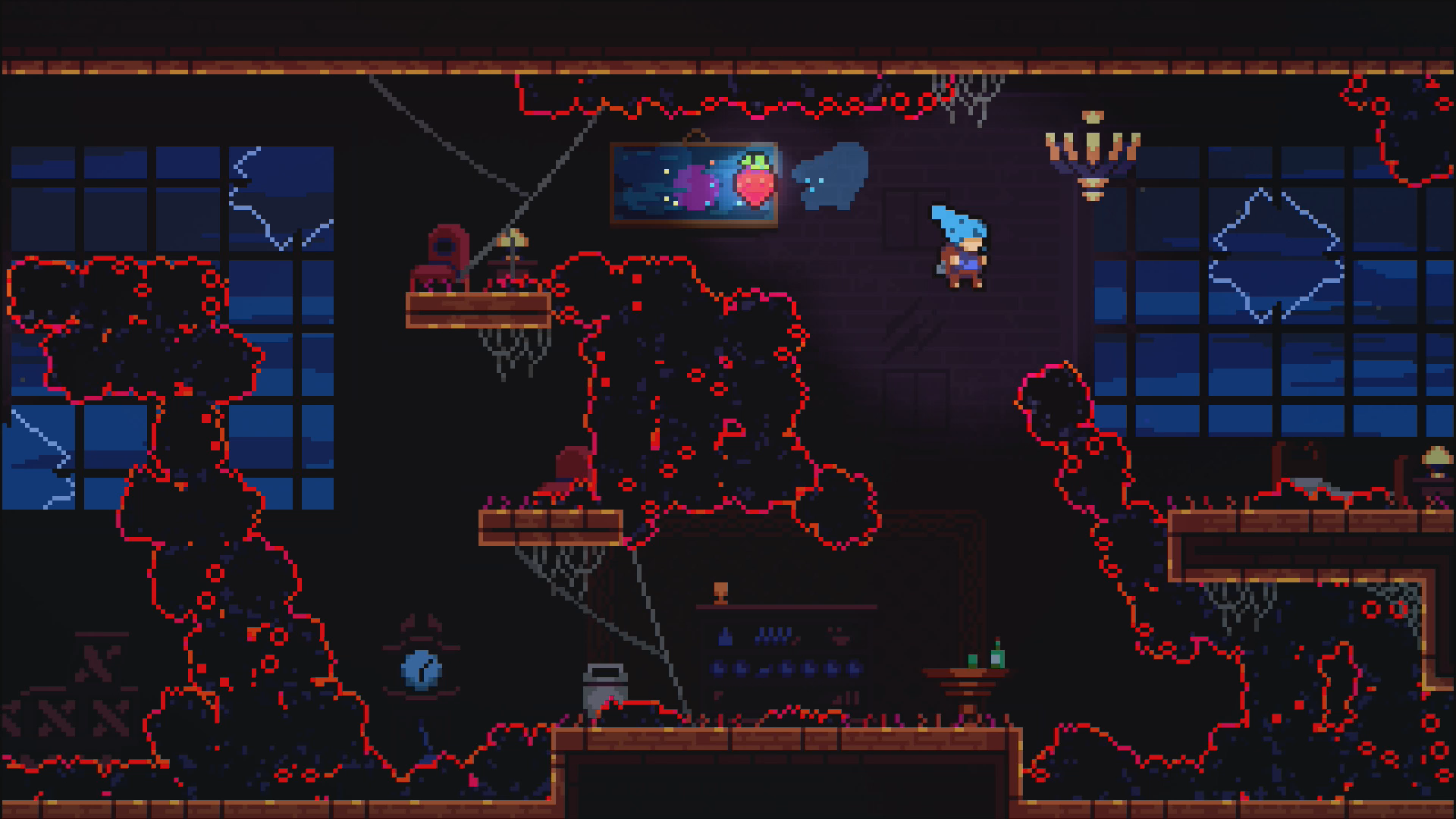
Dust Bunnies: Players like me will encounter a difficulty spike in Chapter 3. On this screen, I’m not allowed to touch the black blobs. Moreover, touching a floor or wall once will generate new blobs, preventing me to backtrack.
Environmental hazards are scattered all throughout: spikes litter floors and walls, objects kill you at a slightest touch, strong winds hinder your movement, and much more! Add this to the fact that I haven’t played platformer games in a while, so it’s no surprise that even the canon storyline is more challenging than it should be.
Constraints conceive creativity
Madeline’s controls are also limited: she can only jump, climb walls, and dash— nothing more. There are no items, souls to collect, nor magic. Her mechanics emphasize the importance of player skill in solving the platforming puzzles. Given this small moveset, clearing a screen may require combining these movements to perform acrobatic maneuvers, or taking advantage of the environment along her way.
This brings us to my first reflection point: the success of Madeline is in my [our] hands. Her wins are my wins, and so are her deaths. It’s not because of a magic item or an overpowered stat boost that will zoom me across the screen. More importantly, puzzles can be cleared in more ways than one: I find it fascinating to watch speedrunners clear screens in ways I never imagined. This removes the “memorization mechanic” where you just need to perform certain button-presses and you’re done. Sure it’s constrained, but it’s flexible enough to endow some personal touch in completing these puzzles. In other words, constraints conceive creativity.
Constraints conceive creativity
Before, I saw my anxiety as a constraint or weakness— I worry a lot and think about things in the future. At first I thought of it as limiting and crippling, especially given the insurmountable Mountain called Life that I need to face.
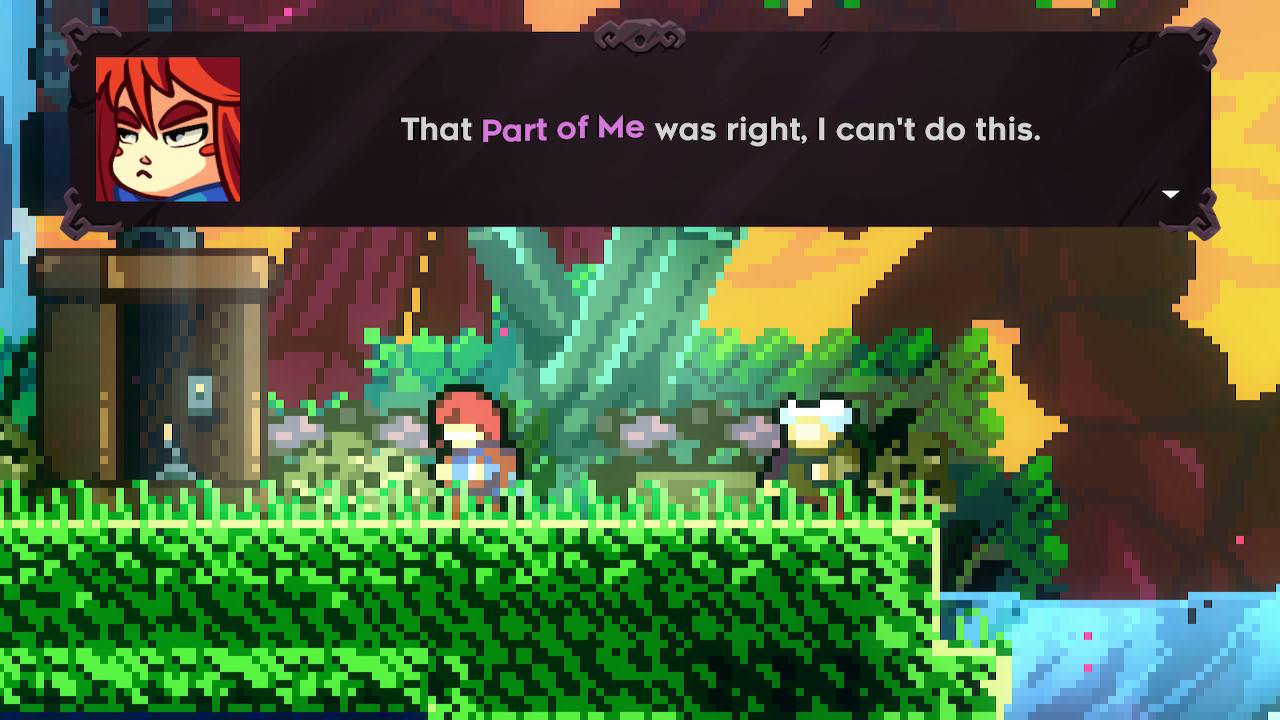
However, as with Madeline’s jump, climb, or dash, constraints conceive creativity.1 I slowly learned to lean-in to this “weakness.” For example, it made me more confident in my planning skills:2 I can anticipate potential paths where things might go wrong, break down vague objectives into clearer ones, and so on. Sure, it’s still difficult, but just like any of Celeste’s platforming puzzles, I know I can clear it given my limited moveset.
Forgiveness and Patience
Celeste is self-aware of its difficulty. A key giveaway is the death counter prominently shown at the end of each level, and some notes such as:
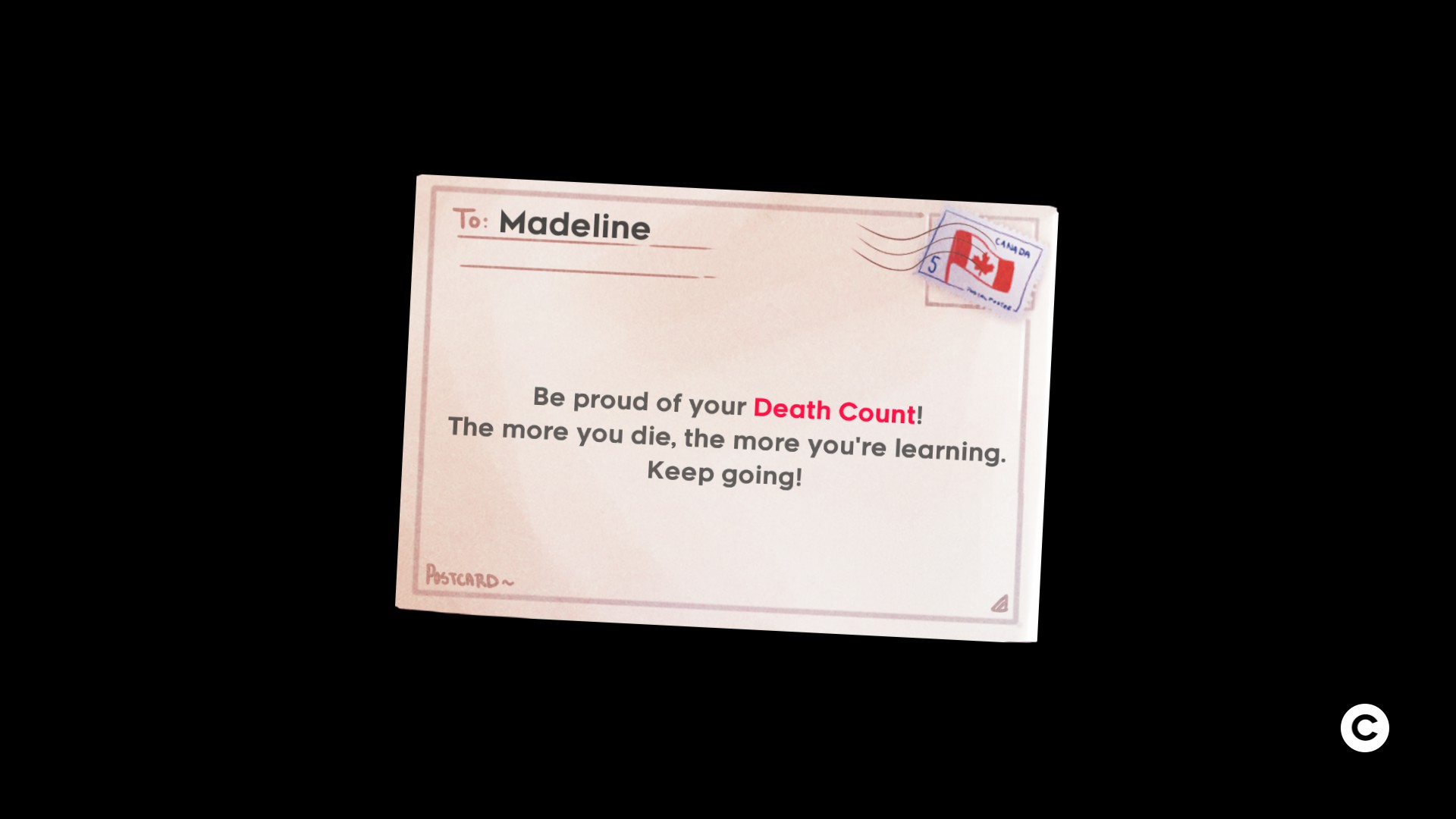
Be proud of your death count: Celeste knows that it’s hard, and yes you’ll die a lot— but these small touches helped lighten the mood and shift my perspective
In some ways, the ideas of Celeste fit precisely in a platformer game: it’s about trying over and over again, while overcoming the urge to give up.
In some ways, the ideas of Celeste fit precisely in a platformer game: it’s about trying over and over again, while overcoming the urge to give up. However, what differentiates Celeste from similar games is its forgiveness and patience. Sure, there’s no health bar, and one tiny mistake kills you, but death doesn’t punish you so hard: instead of repeating the whole chapter, you immediately start at the last screen you’ve been to. In addition, resurrection is quick, Madeline just goes into a Megaman-like poof, and you’re back again.
This differs in some of the platformers I tried (in the course of writing this post) like Super Meat Boy or Dead Cells,3 where there is an element of rage and spite that motivates you to complete a level. Instead, Celeste the game cheers for you and wishes for you to succeed. Inasmuch as Celeste is self-aware of its difficulty, it’s also self-aware that it isn’t impossible— you just gotta keep trying.4
In addition, the game is patient in introducing one mechanic after the other. In the first chapter, it “teaches” you the concept of springs and spikes, then later on you’ll encounter a moving platform, and near the end you’ll see a combination of these mechanics. This “narrative” is done for each chapter, and in a macro-level, throughout the game.5 If, for some instance, I skipped screens and went to the latter parts of the game, I’d definitely feel intimidated once I see those spike-covered floors, moving dust-bunnies, and strong winds in one screen. However, because the game has patiently taught me its mechanics as I progress, I instead find them more manageable.
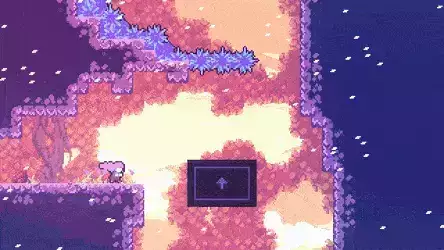
In the end, Celeste’s mechanics allows the player to experience Madeline’s struggles throughout the game, while being forgiving and patient about it. It’s wonderfully-tight, given that the last power-up is simply a double-dash, not some grand zooming ability. The game’s final ascent is still difficult, but it says something: overcoming anxiety and depression is a process— catharsis is important but it doesn’t end there.
Overcoming anxiety and depression is a process— catharsis is important but it doesn’t end there.
The final level is wonderful because it reminds you of how far you’ve come. There will be multiple callbacks to all of the previous chapters’ gimmicks, but this time it feels more doable— it’s all because you failed, you learned, and you tried again.

Story in Sounds
In the previous sections, we saw how the narrative and gameplay mechanics dovetail to form a tight and cohesive experience, enabling me to share with Madeline’s struggles. Those two alone already makes Celeste a wonderful game, but the masterful way it uses its soundtrack to heighten our experiences brings this platformer into greater heights.
A major element of Celeste’s composition is its use of leitmotif, a recurring musical phrase that represents a theme or idea. In the game, this occured both in (1) the melody, and (2) the characters’ “instruments”. Note that I will only touch specific aspects of the soundtrack in this post, there’s definitely a lot that can be written on the game’s OST and I’d happily recommend some works that explored various aspects of Celeste’s music.
Main melodies
The first few minutes of the game introduce us to two recurring melodies: the sound of struggle in the Prologue, and the main theme in First Steps.
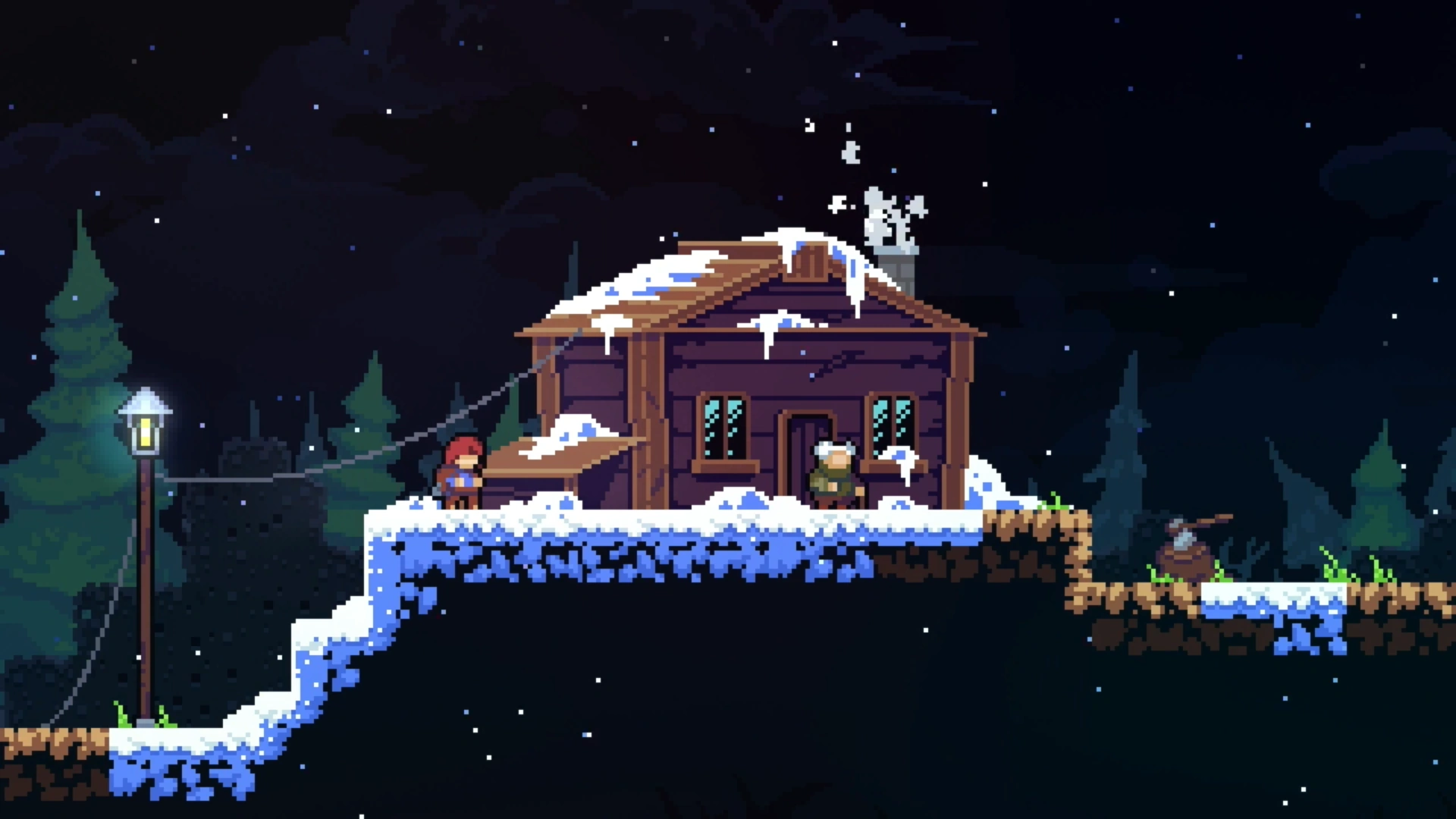
I’m hesitant to label Prologue’s melody as a motif because its callback only happens at the end of the game. When we first encounter it, we’re in the middle of escaping a crumbling bridge. The fast tempo denotes the idea of the struggle, the intensity increases, then it ends with a falling sound.
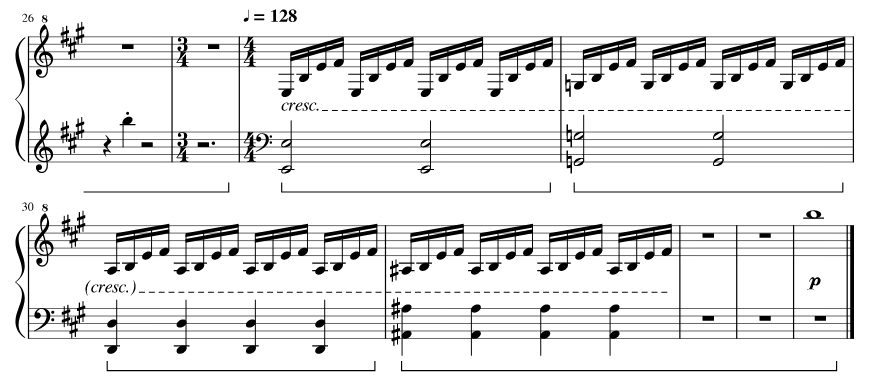
<iframe width="560" height="200" src="https://www.youtube.com/embed/Ctuo3ws3EKs" frameborder="0" allow="accelerometer; autoplay; encrypted-media; gyroscope; picture-in-picture" allowfullscreen></iframe>
Sound of Struggle: Prologue starts off as calm and mysterious, then proceeds with a rapid succession of notes at the 50-second mark.
The Prologue’s music is memorable because my experience with it is unique. After I completed the game and joined Celeste’s subreddit, I learned that the tutorial bird should teach you the dash mechanic as you’re falling right away. In my case, I fell (and laughably died) twice before the tutorial bird showed up.6 Coupled with the falling sound (0:56-0:59), this experience cemented the idea that this game is really hard. Deep in my subconscious, those exact notes and descending tone ingrained the feeling of failure amidst the struggle.
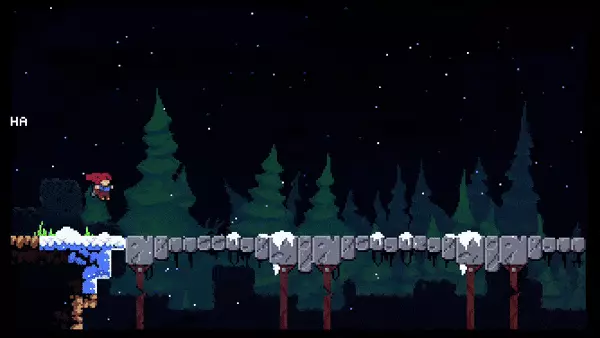
First blood: My first death in the game came from this crumbling bridge
I want you to keep this tone in mind, because its callback later on is satisfying. Moving on, let’s head over one of the most apparent melodies throughout the game.
The first level—and coincidentally its soundtrack, First Steps— introduces us to the main theme:



<iframe width="560" height="200" src="https://www.youtube.com/embed/N8OHSXvneOE" frameborder="0" allow="accelerometer; autoplay; encrypted-media; gyroscope; picture-in-picture" allowfullscreen></iframe>
Sound of Determination: First Steps introduces us right away to the game’s main melody.
I’d daresay that this could even be Madeline’s theme, for we hear this in crucial points of her climb. In the beginning, her theme evokes a sense of wonder and exploration. We (the player) only know about the climb, but none of the emotional undertone Madeline experiences. The atmosphere is blissful and the song’s overall arc is rousing: the initial clap-like beats (0:05) hype us up, and the synth-like beats in the music’s second phase (starting at 1:04) reminds us the difficulty of our ascent. It is challenging yet promising, chock-full of determination that perfectly describes our main character.
[Madeline’s theme] is challenging yet promising, chock-full of determination that perfectly describes our main character.
Accompaniment
Madeline’s theme finds us back in Madeline and Theo (1:01), after she experienced all major challenges on her way up: being chased by her dark doppelgangers, a difficulty spike in Chapter 3, a boss sequence with a ghastly concierge, a panic-attack, and so on. Madeline and Theo is played during a heartwarming scene with Theo, their campfire alit, sharing stories about their life. Because the last time we heard her theme was in First Steps, the callback on this scene evokes newfound determination, but this time, aware of the struggle the Mountain possesses.
Character instruments also played a huge role in this scene. As a player, I know by now that Madeline is represented by the piano, and Theo by the guitar. In Madeline and Theo, our protagonist is not alone (and perhaps this is the first song where Madeline’s piano is played with another instrument). She is accompanied by a guitar, and they play her theme in a harmonious fashion.
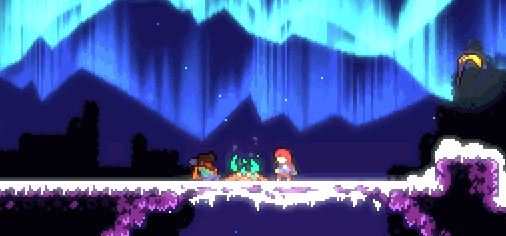
<iframe width="560" height="200" src="https://www.youtube.com/embed/__oZ-LYZ8pU?playlist=dTIeaqNXseY" frameborder="0" allow="accelerometer; autoplay; encrypted-media; gyroscope; picture-in-picture" allowfullscreen></iframe>
Not alone: Madeline and Theo may as well be the first time we hear Madeline’s piano be accompanied by a character instrument. This song then segues to Starjump, which amps up the emotions of this cutscene.
It is also noteworthy that Starjump comes after this song. It is a perfect interlude that gives a more heightened feeling of overcoming diffifulties along our way.
Determination comes into play again in Confronting Myself, at the final “boss battle.” Madeline is determined to reach into Badeline, resulting into a “reverse chase sequence” where we’re the one running after Badeline and she’s the one running away from us (while shooting lasers and deathly orbs along our way). In-game, this arc was very long, testing the player’s patience and mettle all throughout.
We also hear the synth, representing Badeline, throughout the game. It tries to overpower Madeline’s theme (and her instrument), in a goth-like chiptune repertoire—perfectly apt for a boss battle.

<iframe width="560" height="200" src="https://www.youtube.com/embed/b_oEDGONSc4" frameborder="0" allow="accelerometer; autoplay; encrypted-media; gyroscope; picture-in-picture" allowfullscreen></iframe>
Confronting Myself: Madeline and Badeline’s instruments overpower each other in this epic boss battle. Again, we hear Madeline’s theme in the 1:12 mark
Refrain
Remember Prologue? Its frantic melody will reappear again in Reach for the Summit, during the final ascent. Because my previous experience taught me that this song is about failure (because oh boy, I died twice in the Prologue), I got intimidated when I heard its initial notes, especially during the summit run. As the notes race, I’m starting to doubt if I can actually finish this game…
<iframe width="560" height="200" src="https://www.youtube.com/embed/Ctuo3ws3EKs?start=50&end=62" frameborder="0" allow="accelerometer; autoplay; encrypted-media; gyroscope; picture-in-picture" allowfullscreen></iframe>
Frantic Notes: I started hearing these notes again from the Prologue, teasing
me for the difficulty to come.
But in the Final Chapter of Celeste, something has changed, listen carefully on the 30-second mark. Compare this with the original Prologue above:
<iframe width="560" height="200" src="https://www.youtube.com/embed/iDVM9KED46Q?end=45" frameborder="0" allow="accelerometer; autoplay; encrypted-media; gyroscope; picture-in-picture" allowfullscreen></iframe>
Subtle change: I want you to listen carefully to the opening tune of the final ascent’s music,
Reach for the Summit.
There’s no more falling tone! It’s a subtle difference, but it was replaced by something more heroic (the rhythm even reminds me of the Avengers theme). It seems to tell me: “Yes, this is going to be difficult, but this time around, you can do this.”

<iframe width="560" height="200" src="https://www.youtube.com/embed/iDVM9KED46Q" frameborder="0" allow="accelerometer; autoplay; encrypted-media; gyroscope; picture-in-picture" allowfullscreen></iframe>
…and then it transitions back to Madeline’s theme (00:45 onwards). She has found her bearings and begins the climb.
Summit
In the final leg of the Summit, during the 3000-m mark and where the checkpoints appear, the Prologue’s melody comes up again. Like the last time, it doesn’t end with a falling tone but a heroic one. But what you hear next is powerful:
<iframe width="560" height="200" src="https://www.youtube.com/embed/iDVM9KED46Q?start=478" frameborder="0" allow="accelerometer; autoplay; encrypted-media; gyroscope; picture-in-picture" allowfullscreen></iframe>
Madeline’s theme plays, but it is now a combination of the Piano and the Synth, singing in a harmonious fashion. During this part, everything coincides perfectly: the narrative tells us how Madeline works with her anxiety and depression through Badeline, the mechanic grants us the double-dash power-up, a product of Madeline and Badeline’s fusion, and the music gives us a high-beat, perfect symphony of Madeline and Badeline’s instruments— all combined to pack the perfect gameplay experience of a lifetime.
![]()
In the next section, I’ll conclude this series with a short synthesis, a reflection on my personal journey, and a short discussion on how Celeste has changed my view on gaming in general.
Other Sections
- Part I: Introduction and Storytelling: I’ll introduce Celeste the game, and talk about how its strong narrative has drawn me into completing it.
- Part III: Conclusion (August 22): in the final part of this series, I’ll end with a short Conclusion and reflection on Celeste overall, how it changed my perception on video games, and more.
Resources
Here are some of the resources and materials that I used and watched to learn more and appreciate the beauty of Celeste.
Primary Sources
- GDC Level Design Workshop: Designing Celeste: a GDC session where Celeste’s lead developers talked about the game’s level design. It’s pretty interesting to see how they conceptualized this early on (note that the talk was done in 2017, before Celeste was released and way before it has been recognized as a hit).
- Celeste TGH Speedrun in 1:28:03: this is a Celeste speedrun by TGH, see how a pro-player plays the game!
Secondary Sources
- How Celeste Teaches You Its Mechanics and Why Does Celeste Feel So Good to Play?: two of my go-to videos if I want to see an in-depth analysis of Celeste’s game-design. The first one focuses on level-design, and the latter looks into Madeline’s fluid controls.
- The Anxiety of Celeste and its Music: this video analyzes Celeste’s music in the context of anxiety and stress. Its amazing because it also dwells on physiological stress, using low-intensity and high-intensity music to stimuluate eustress or destress.
- How Celeste’s Mirror Temple Creates Fear: a good study on game-level design on how Celeste’s Chapter 5 evokes the emotion of Madeline to the player.
- What Makes Celeste’s Assist Mode Special: one of Game Maker’s Toolkit study on what makes Celeste a very accessible game, emphasizing the importance of developer intention while balancing player preference.
- The Magic of Celeste’s Farewell DLC: I don’t think I’ll be able to finish all of Celeste’s B and C sides, much more its DLC soon. Thus, I’ll hand you over to this video that dives into a good analysis of Celeste’s Epilogue, Farewell. I see Farewell as a critique on Madeline’s determination (stubborn determination, to a fault), and also underscores the feeling of grief.
Footnotes
-
A bit off-topic, but this learning, constraints conceive creativity made me drawn to pixel art. In Pixel Art, you’re mostly working on a small canvass, and it “forces” you to creatively represent small details in low-resolution. ↩
-
I took Clifton’s StrengthsFinder test a few months ago, and my Top 2 Strength is Strategic. It is expressed as someone who “create alternative ways to proceed and think in terms of options.” It feels validating to see it expressed that way! ↩
-
Don’t get me wrong, I love Dead Cells! Albeit for different reasons (mostly on combat, tactics, and adaptability). ↩
-
I have yet to try the Assist Mode to practice some advanced maneuvers as I learn how to speedrun. Turning on Assist Mode “breaks” the game. However, the developer’s messaging is wonderful: it’s not cheating, it’s OK to ask for help and there’s no shame in that. ↩
-
The creators of Celeste conducted a workshop in GDC (Games Developers Conference) about the game’s level-design. It’s definitely worth a watch if you have half an hour to spare! Very insightful and it shows the level of craftsmanship Matt and his team does. ↩
-
So yes folks, I died in the Prologue! ↩